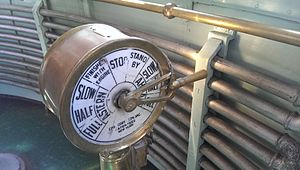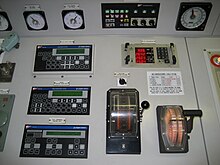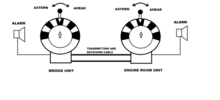131:
247:
34:
238:
control mode, the bridge handle directly controls the engine set point. When in Engine
Control Room mode the bridge handle sends a telegraph signal to the ECR and the ECR handle controls the set point of the control system. In local control, the remote control system is inactive and the bridge handle sends a telegraph signal to the local control position and the engine is operated by its manual controls in the engine room.
273:
209:
225:
in the engine room in the event that the remote control system should fail. The EOT is required to be electrically isolated from the remote control system. However, it may be mechanically linked to the main control handle, allowing telegraph orders to be given using the same user interface as for remote control orders. Traditional EOTs (though in a more modern form) can still be found on all
224:
as a remote control device rather than an EOT, though it is still often referred to by the traditional name. This is somewhat confusing, as the classification society rules for merchant ships still in fact require an EOT to be provided, to allow orders to be transmitted to the local control position
237:
Remote control systems on modern ships usually have a control transfer system allowing control to be transferred between locations. Remote control is usually possible from two locations: the bridge and the Engine
Control Room (ECR). Some ships lack a remote control handle in the ECR. When in bridge
187:
Traditional EOTs required a pilot wanting to change speed to "ring" the telegraph on the bridge, moving the handle to a different position on the dial. This would ring a bell in the engine room and move their pointer to the position on the dial selected by the bridge. The engineers hear the bell
263:
sounds at both ends. Accordingly, the watch-keeping engineer acknowledges the order by moving the handle of the engine room EOT to the required position and takes necessary action. This sends an electrical signal to the bridge EOT unit, causing its pointer to acquire the respective position. The
174:
In its original form, from the 19th century until about 1950, the device usually consisted of a round dial about 9 inches (230 mm) in diameter with a knob at the center attached to one or more handles, and an indicator pointer on the face of the dial. There would also be a
233:
as they still require an engineering crew member to operate the throttles for the steam turbines that drive the propellers. EOTs can also be found on older vessels that lack remote control technology, particularly those with conventional steam engines.
195:
For urgent orders requiring rapid acceleration, the handle is moved three times so that the engine room bell is rung three times. This is called a "cavitate bell" because the rapid acceleration of the ship's propeller will cause the water around it to
254:
At least two telegraph units and alarms must be installed, one on the bridge and one in the engine room. The order is given by moving the bridge unit's handle to the desired position on the dial face. This sends an
188:
and move their handle to the same position to signal their acknowledgment of the order, and adjust the engine speed accordingly. Such an order is called a "bell"; for example, the order for a ship's maximum speed,
212:
Modern engine room telegraph/remote control handle in Engine
Control Room (ECR) on board a merchant ship. ECR Lever is not currently active as the system pictured is in direct bridge control mode.
200:, causing a lot of noise and wear on the propellers. Such noise is undesirable during conflicts because it can give away a vessel's position.
216:
On most modern vessels with direct combustion engines or electric propulsors, the main control handle on the bridge acts as a direct
98:
70:
259:
to the EOT placed in the engine room whose pointer acquires a position according to the signal given from the bridge. An audible
51:
179:(RPM) indicator, worked by a hand crank. Modern EOTs on vessels which still use them use electronic light and sound signals.
77:
84:
117:
66:
461:
55:
403:
22:
334:
order, giving the precise engine speed desired. Many modern ships have the following dial indications:
226:
91:
466:
44:
430:
331:
221:
176:
8:
220:
with no intervening engine room personnel. As such, it is regarded under the rules of
256:
230:
455:
159:
369:"Finished with engines" and "standby" conveyed via separate control panel.
378:
276:
264:
alarm stops ringing to acknowledge that the order has been carried out.
189:
163:
130:
197:
407:
155:
246:
33:
383:
217:
272:
208:
260:
151:
338:
Full ahead navigation (on notice to increase or reduce)
203:
286:
Many past ships have the following dial indications:
58:. Unsourced material may be challenged and removed.
166:to power the vessel at a certain desired speed.
453:
21:"Chadburn" redirects here. For other uses, see
330:Any orders could also be accompanied by an
267:
118:Learn how and when to remove this message
271:
245:
207:
129:
428:
404:"The Chadburn Ships' Telegraph Society"
150:, is a communications device used on a
454:
250:Block diagram of the EOT signal system
429:Halpern, Samuel (18 September 2007).
241:
290:Flank ahead (1940–present) (US only)
56:adding citations to reliable sources
27:
16:Communications device used on a ship
204:Compared to remote control throttle
13:
14:
478:
282:'s bridge engine order telegraph
32:
326:Emergency astern (1940–present)
222:marine classification societies
169:
43:needs additional citations for
422:
396:
1:
389:
192:, is called a "flank bell".
182:
7:
372:
10:
483:
311:Finished with main engines
162:to order engineers in the
20:
146:, also referred to as a
67:"Engine order telegraph"
431:"Speed and Revolutions"
158:) for the pilot on the
283:
268:Typical dial positions
251:
213:
177:revolutions per minute
140:engine order telegraph
135:
134:Engine order telegraph
462:Watercraft components
435:Encyclopedia Titanica
275:
249:
227:nuclear powered ships
211:
133:
52:improve this article
410:on 27 November 2021
284:
252:
242:Order transmission
214:
136:
257:electrical signal
128:
127:
120:
102:
474:
446:
445:
443:
441:
426:
420:
419:
417:
415:
406:. Archived from
400:
356:Dead slow astern
314:Dead slow astern
123:
116:
112:
109:
103:
101:
60:
36:
28:
482:
481:
477:
476:
475:
473:
472:
471:
467:Control devices
452:
451:
450:
449:
439:
437:
427:
423:
413:
411:
402:
401:
397:
392:
375:
350:Dead slow ahead
302:Dead slow ahead
270:
244:
206:
185:
172:
124:
113:
107:
104:
61:
59:
49:
37:
26:
17:
12:
11:
5:
480:
470:
469:
464:
448:
447:
421:
394:
393:
391:
388:
387:
386:
381:
374:
371:
367:
366:
363:
360:
357:
354:
351:
348:
345:
342:
339:
328:
327:
324:
321:
318:
315:
312:
309:
306:
303:
300:
297:
294:
291:
269:
266:
243:
240:
205:
202:
184:
181:
171:
168:
126:
125:
40:
38:
31:
15:
9:
6:
4:
3:
2:
479:
468:
465:
463:
460:
459:
457:
436:
432:
425:
409:
405:
399:
395:
385:
382:
380:
377:
376:
370:
364:
361:
358:
355:
352:
349:
346:
343:
340:
337:
336:
335:
333:
325:
322:
319:
316:
313:
310:
307:
304:
301:
298:
295:
292:
289:
288:
287:
281:
280:
274:
265:
262:
258:
248:
239:
235:
232:
228:
223:
219:
210:
201:
199:
193:
191:
180:
178:
167:
165:
161:
157:
153:
149:
145:
141:
132:
122:
119:
111:
100:
97:
93:
90:
86:
83:
79:
76:
72:
69: –
68:
64:
63:Find sources:
57:
53:
47:
46:
41:This article
39:
35:
30:
29:
24:
19:
438:. Retrieved
434:
424:
412:. Retrieved
408:the original
398:
368:
329:
285:
278:
253:
236:
215:
194:
186:
173:
170:Construction
147:
143:
139:
137:
114:
105:
95:
88:
81:
74:
62:
50:Please help
45:verification
42:
18:
379:Flank speed
365:Full astern
362:Half astern
359:Slow astern
323:Full astern
320:Half astern
317:Slow astern
190:flank speed
164:engine room
456:Categories
390:References
347:Slow ahead
344:Half ahead
341:Full ahead
299:Slow ahead
296:Half ahead
293:Full ahead
231:submarines
78:newspapers
23:Chadbourne
440:6 January
277:USS
183:Operation
156:submarine
108:July 2011
384:Teleseme
373:See also
218:throttle
198:cavitate
148:Chadburn
305:Standby
279:LST-325
92:scholar
414:2 July
160:bridge
144:E.O.T.
94:
87:
80:
73:
65:
261:alarm
99:JSTOR
85:books
442:2013
416:2011
353:Stop
308:Stop
229:and
154:(or
152:ship
71:news
332:RPM
142:or
138:An
54:by
458::
433:.
444:.
418:.
121:)
115:(
110:)
106:(
96:·
89:·
82:·
75:·
48:.
25:.
Text is available under the Creative Commons Attribution-ShareAlike License. Additional terms may apply.



